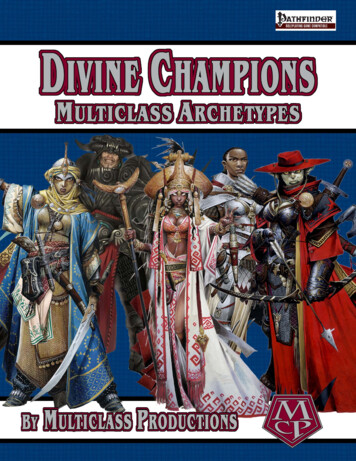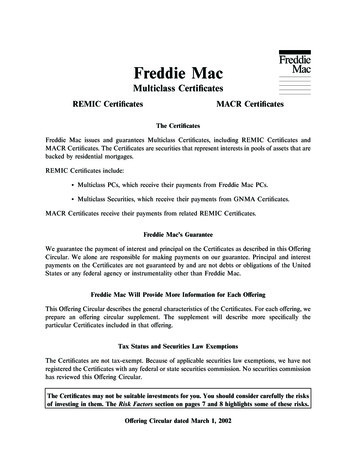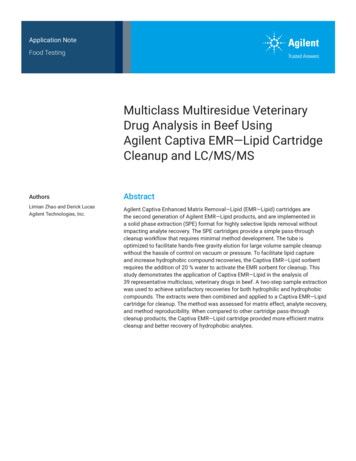
Transcription
MULTICLASS PRODUCTIONS (MCP)PresentsDIVINE CHAMPIONSMULTICLASS ARCHETYPESCREDITSMCP Project Leader: Jim Wettstein (Elghinn Lightbringer)MCP Lead Developers: Michael Pruess (Flak), Tyler Beck (Cartmanbeck),M. Adair (Raiderrpg), and Morgan Boehringer (Oceanshieldwolf).Additional Contributors: Benjamin Callahan1 (Big Lemon)and Margherita Tramontano2 (Bardess).Cover Art: “Alahazra”, the “Antipaladin”, “Imrijka”, “Kyra”, and “Seelah” - Property of PaizoPublishing, Pathfinder RPG, and Pathfinder Society.Interior Art: Property of Paizo Publishing, Pathfinder RPG, and Pathfinder Society.Additional Interior Art: Jim Wettstein (Elghinn Lightbringer).Graphic Design and Layout: Jim Wettstein (Elghinn Lightbringer).Editing and Development: Jim Wettstein (Elghinn Lightbringer),Michael Pruess (Flak), Tyler Beck (Cartmanbeck), M. Adair (Raiderrpg),and Morgan Boehringer (Oceanshieldwolf).Publisher: Multiclass ProductionsSpecial Thanks: To all others who took part in the collaborative effortson the Multiclass Archetype threads.Compatibility with the Pathfinder Roleplaying Game requires the Pathfinder Roleplaying Game from Paizo Publishing, LLC.See http://paizo.com/pathfinderRPG for more information on the Pathfinder Roleplaying Game. Paizo Publishing, LLCdoes not guarantee compatibility, and does not endorse this product.
TABLE OF CONTENTSMULTICLASS ARCHETYPES4MULTICLASS PRODUCTIONS5CHAPTER 1: ANTIPALADIN MUTLICLASS ARCHETYPES6CHAPTER 2: CLERIC MUTLICLASS ARCHETYPES9Guidelines for Multiclass ArchetypesBlackguard AssassinBlooded TyrantBattle AdeptDivine AgentDivine ExemplarPactbound eyInfernalVerdantRage PriestTemple DancerTerrain PatriarchCHAPTER 3: INQUISITOR MUTLICLASS ARCHETYPESTemple AssassinWitchfinderCHAPTER 4: ORACLE MUTLICLASS ARCHETYPESElemental Savant1CHAPTER 5: PALADIN MUTLICLASS ARCHETYPESAngelic KnightCassisianEvolutionsDivine DuelistDivine EmissaryFeral ChampionMystic DefenderRadiant Herald2Weeping ExecutionerCHAPTER 6: MCA 3232525262729303234353739DomainsFeatsRogue Talents393940Templates40Advanced TalentsPAIZO RULES, OGL, AND COMMUNITY USE POLICY4041
MULTICLASS ARCHETYPESMulticlassing is one of the great traditions of fantasy roleplaying gamesand has resulted in a multitude of archetypical combinations. From thedeadly rogue/wizard to the synergistic ranger/cleric, multiclassing allows acharacter to focus on a primary class while taking another, granting themthe ability to more effectively deal with challenges. However, throughtraditional multiclassing, a character must slow his level advancement andability progression in one class to gain levels and their subsequent abilitiesin a new class. Although many players find the idea of multiclassingappealing, some do not like the necessity of sacrificing the efficacy ofcertain abilities from their primary class to gain those of another class. Inthat spirit, by using multiclass archetypes, characters can retain primaryfeatures from their primary class without compromising their potency,while exchanging less desirable class features for those from a secondaryclass. The multiclassing character only gains abilities from their secondaryclass in part, and not at their full potency like they would if they hadselected that class as their primary class. The following multiclassarchetypes represent a variety of classic multiclass combinations.GUIDELINES FOR MULTICLASS ARCHETYPESMulticlass archetypes, like traditional multiclassing, are a blend of twodistinct classes. The first class in which a character gains experience isconsidered that character’s favored class. When one multiclasses, thecharacter selects another class in order to diversify his repertoire of skillsand class abilities, and must adhere to certain established rules. Thefollowing terms and their descriptions provide the general guidelines usedto create multiclass archetypes.Primary Class: The primary class of a multiclass archetype is the classupon which the archetype is based, and supplies the base hit dice, skills,skill ranks, alignment restrictions, attack bonus, saves, and class abilitiesfor the archetype. All aspects of the primary class are adhered to within themulticlass archetype, except those altered according to archetype’ssecondary class. The primary class is also the same as the class section inwhich the archetype is listed. In traditional multiclassing, the primary classis the character’s favored class, as selected at first level.Secondary Class: The secondary class of a multiclass archetypeprovides the alternate class abilities that replace those of the primary class.In traditional multiclassing, the secondary class is a character’s class hechooses to gain experience in addition to his favored class.Alignment Restrictions: Multiclass archetypes must adhere to thealignment restrictions of the multiclass archetype, as they would for a coreor base class. Although traditional rules restrict classes with conflictingalignments from being multiclassed (Barbarian/Paladin), such multiclassarchetypes may follow the alignment restrictions of the primary orsecondary class, or a new alignment restriction may be created specificallyfor the archetype.Hit Dice: Multiclass archetypes retain the Hit Dice of the primary class.If the Hit Dice of the secondary class is two steps away (above or below)from that of your primary class, you gain new Hit Dice that is one stepbelow or above that of your primary class. For example, a rogue/wizardwould retain his d8 Hit Dice, while a fighter/wizard would receive d8 HitDice instead of the normal d10.Bonus Skills and Ranks: Multiclass archetypes use the skill set andranks of its primary class. However, multiclass archetypes gain bonus skillsand ranks at each level based upon their secondary class. Depending uponthe discrepancy of skills and ranks between the primary and secondaryclasses, the archetype provides additional skills and ranks to uphold themulticlass flavor of the archetype. If the archetype’s secondary class gainsranks at each level that are the same as or 2 above that of the primary class,the archetype gains three bonus skills of the character’s choice as selected
from the skill set of the secondary class, but gain no additional skill ranksat each level. If the secondary class gains ranks at each level that are 4 ormore above that of the primary class, the archetype gains six bonus skillsand 2 bonus ranks at each level. For example, a fighter/rogue archetype hasfighter as its primary class and rogue as its secondary class. Thus, thefighter/rogue archetype uses the fighter skill list, but gains six bonus skillsfrom the rogue’s skill list of the character’s choice, and gains a total of 4ranks at each level. Subsequently, a bard/ranger would use the bard skilllist, but only gains three bonus skills from the ranger skill list and uses thebard’s ranks at each level.Base Attack Bonus: Multiclass archetypes use the base attack bonus oftheir primary class. If the secondary class has a base attack bonus two stepsabove that of the primary class, the archetype increases its base attackbonus by one step (1/2 BAB becomes 3/4 BAB, 3/4 BAB becomes fullBAB). Thus, a sorcerer/fighter archetype would have a base attack bonus of3/4 instead of 1/2.Saving Throws: Multiclass archetypes gain a new set of saving throws,based upon the classes used to create them. If the two classes used to createa multiclass archetype have the same saves (Witch/Sorcerer), or if theyoverlap in whole or in part (Cleric/Paladin), the new archetype gains theoriginal saves of the two classes. If the two classes each have one goodsave that does not overlap, the new archetype gains two good saves. If thetwo classes each have two good saves that do not completely overlap(Alchemist/Druid), the new archetype gains only two good saves as basedupon the flavor of the archetype. Should either class have three good saves(Monk), retention of all three is dependent on the flavor of the archetype.Otherwise it only gains two good saves.Weapon and Armor Proficiency: Multiclass archetypes use theweapon and armor proficiency of the primary class, but will often gainadditional or alternate weapon proficiency acquired from the secondaryclass. Depending upon the secondary class, the archetype may also gainadditional proficiency in armor, although the primary class restrictions willstill apply, such as a druid’s restriction on using metal armors. Somearchetypes may gain armor proficiency that hampers certain class abilities,such as with arcane spellcasters. In such cases, if the archetype flavorwarrants it, the archetype will gain a class feature allowing it to use suchabilities with armor in an incremental progression, similar to the armorprogression of the Magus (see Ultimate Magic). The overall power of themulticlass archetype determines whether such allowances are warranted ornot.Spell Progression: Multiclass archetypes with a spellcasting primaryclass continue to cast spells normally in that class. If the archetype’sprimary class has a spellcasting ability that is two or more steps below thatof the secondary class, the archetype’s spellcasting ability increases by onestep. If the primary class has no spellcasting, depending upon thearchetype, it may gain a 1/2 caster spell progression or a uniqueprogression table of its own. Additionally, the multiclass archetype maygain the Diminished Spellcasting ability, retaining the primary’s class’sspell progression, but reducing the number of spells cast at each spell levelper day, or the number of spells known of each spell level, depending uponthe multiclass archetype. Unless noted otherwise, an archetype has a casterlevel equal to its archetype level.Class Features: Unless otherwise noted in a multiclass archetype'sentry, it retains all the class features of its primary class. Usually some ofthese primary class features are swapped out for some class features fromthe secondary class, along with some all-new abilities meant to 'bridge thegap' between the classes. The rules for these trades are the same as the rulesfor using alternate class features in Paizo's archetype rules (the latestversion of which is in Ultimate Combat, p. 24)*. By default, your "classlevel" for the purpose of determining the effects of any class featuregranted by a multiclass archetype is equal to your levels in that multiclassarchetype. Specific abilities may operate differently; these differences areexplained in the ability's description.Capstone Abilities: Multiclass archetypes typically retain the capstoneability of their primary class, and rarely gain the capstone ability of theirsecondary class. However, depending upon the flavor of the archetype, itmay be required to “swap” the capstone ability of the primary class, orcreate a completely unique and flavorful one, much like normal classfeatures (see above).Favored Classes: There are two options pertaining to the rules of acharacter’s favored class, and are subject to GM approval. Upon taking amulticlass archetype, the archetype itself becomes the character’s favoredclass, and gains all benefits of a favored class each level. Alternately, upontaking a multiclass archetype, the archetype’s primary class (or secondaryclass) is designated as the character’s favored class (his choice), andtherefore gains the benefits of a favored class at every odd level (1, 3, 5,etc.) of the multiclass archetype. In the case of Racial Favored ClassBonuses appropriate to one of the MCA's classes, a character may takethem, but he may gain no benefit in some cases. Additional benefits can begained by taking the Multiclass Adept feat.Feats: Multiclass archetypes gain feats according to their leveladvancement, as normal. However, when selecting feats that have class andlevel requirements (such as Greater Weapon Focus, WeaponSpecialization, etc.), a character using a multiclass archetype counts hislevel for feats with his primary class as a prerequisite, and half his level forfeats with his secondary class as a prerequisite, unless otherwise noted inthe multiclass archetype’s description.Class Archetypes: Multiclass archetypes may be used with the classarchetypes presented in the Advanced Player’s Guide, Ultimate Magic,Ultimate Combat, or any similar Pathfinder RPG source books, based uponcompatibility and GM approval.Disclaimer: While individual multiclass archetypes may be compatiblewith normal archetypes as long as all required class features to be replacedare present (and replace those class features when they would normallyoccur within the multi-class archetype, not when specified by the basearchetype), like any other archetype they do count as the base class for allpurposes. You cannot take levels in Battle Adept and Divine Agent, forinstance (as both are Cleric multiclass archetypes), though you could takelevels in both Divine Emissary and Silent Warrior (making you effectivelya Paladin/Cleric/Fighter/Rogue). These classes stack and apply allappropriate abilities as any archetype or class level would, as per themulticlassing rules in the Core Rulebook (page 30). Remember that oncethe character has a level in a multiclass archetype they cannot take theclasses within that archetype separately, nor any alternate class of thoseclasses contained therein.*Note: Although these guidelines have been presented here, creating a Multiclass Archetype is an art form, and requires a certain level of ingenuity,creativity, and understanding of the basic rules of the Pathfinder Roleplaying Game.MULTICLASS PRODUCTIONS (MCP)Multiclass Productions is a nonprofit organization, consisting of five like-minded individuals. Together they have developed what they believe to be the bestmethod for multiclassing in the Pathfinder RPG. Additional information on Multiclass Archetypes and other related collaborative works can be found at thefollow sites:MCArchetypes WikiMulticlass Archetypes Discussion Thread IMulticlass Archetypes Discussion Thread IIMulticlass Archetypes Discussion Thread IIIPathfinder CommunityPathfinder Multiclass Archetypes - The Only Way to Multiclass
CHAPTER 1: ANTIPALADIN MULTICLASS ARCHETYPESBLACKGUARD ASSASSINWhile antipaladin’s are viewed as purely evil and malevolent, theblackguard assassin is feared as a deadly killer with the honed skills of afrontline combatant. Using the stealth and death attacks of an assassin, theblackguard assassin can study his mark from afar, and slay him the nextinstant without anyone realizing it. Then, under the guise of a gruff andpowerful warrior, he can escape the scene without being conspicuous. Hiscombination of evasive maneuvers, fellfire strikes, precision attacks, androguish capacities make the blackguard assassin a fearsome foe to behold.Primary Class: Antipaladin.Secondary Class: Rogue.Alignment: Any evil.Hit Dice: d10.Bonus Skills and Ranks: The blackguard assassin may select six rogueskills to add to his class skills in addition to the normal antipaladin classskills. The blackguard assassin gains a number of ranks at each level equalto 4 Int modifier.Weapon and Armor Proficiency: The blackguard assassin is proficientwith all simple and martial weapons, with all types of armor (heavy, light,medium), but not with shields.Smite Good (Su): This is exactly like the antipaladin ability of thesame name, except that the blackguard assassin can smite good 1/dayat 1st level, and an additional time per day every six levelsthereafter, to a maximum of 4/day at 19th level.Sneak Attack: At 2nd level, a blackguard assassin gains therogue’s sneak attack ability, except that this extra damage is 1d6at 2nd level, and increases by 1d6 every four blackguardassassin levels thereafter. This stacks with any classthat grants the sneak attack class feature. Thisability replaces touch of corruption.Poison Use: At 3rd level, a blackguardassassin is trained in the use of poison and cannotaccidentally poison himself when applying poison to ablade. This ability replaces plague bringer.Cruelty (Su): This is exactly like the antipaladin ability of thesame name, except that each cruelty adds an effect to the blackguardassassin’s sneak attack. Alternatively, each time that theblackguard assassin could select a cruelty, he can select a roguetalent for which he qualifies instead. At 12th level, a blackguardassassin can select an advanced talent whenever he couldselect a rogue talent.Evasion (Ex): At 4th level, a blackguard assassin can avoid evenmagical and unusual attacks with great agility. If he makes asuccessful Reflex saving throw against an attack that normally deals halfdamage on a successful save, he instead takes no damage. Evasion can beused only if the blackguard assassin is wearing light armor, medium armor,or no armor. A helpless blackguard assassin does not gain the benefitTable: Blackguard onus 1 2 3 4 5 6/ 1 7/ 2 8/ 3 9/ 4 10/ 5 11/ 6/ 1 12/ 7/ 2 13/ 8/ 3 14/ 9/ 4 15/ 10/ 5 16/ 11/ 7/ 2 17/ 12/ 7/ 2 18/ 13/ 8/ 3 19/ 14/ 9/ 4 20/ 15/ 10/ 5FortSave 2 3 3 4 4 5 5 6 6 7 7 8 8 9 9 10 10 11 11 12RefSave 2 3 3 4 4 5 5 6 6 7 7 8 8 9 9 10 10 11 11 12WillSave 0 0 1 1 1 2 2 2 3 3 3 4 4 4 5 5 5 6 6 6SpecialAura of evil, detect good, smite good 1/daySneak attack 1d6, unholy resilienceAura of cowardice, cruelty, poison useEvasion, fellfire strike 1d6Death attack, fiendish boonCruelty, sneak attack 2d6, uncanny dodgeSmite good 2/dayAura of despair, fellfire strike 2d6CrueltySneak attack 3d6True deathCruelty, fellfire strike 3d6Improved uncanny dodge, smite good 3/dayQuiet death, sneak attack 4d6CrueltyFellfire strike 4d6Hide in plain sightCruelty, sneak attack 5d6Smite good 4/dayDeath strike, fellfire strike 5d6
of evasion. This ability, uncanny dodge, and improved uncanny dodgereplace the antipaladin’s spellcasting ability.Fellfire Strike (Su): At 4th level, a blackguard assassin can wreath hisweapon in fiendish flame, causing terrible wounds to open on those hestrikes. Each day he can use this ability a number of times equal to 1/2 hisblackguard assassin level his Charisma modifier. This fiendish fire deals1d6 points of damage at 4th level, plus an additional 1d6 points of damageevery four levels thereafter, to a maximum of 5d6 damage. Using thisability is a swift action that does not provoke attacks of opportunity. Thisability replaces channel negative energy.Death Attack (Ex): At 5th level, the blackguard assassin gains theassassin’s death attack ability. This ability replaces smite good 2/day,4/day, and 6/day.Fiendish Boon (Su): This is exactly like the antipaladin’s ability of thesame name, except that the blackguard assassin must select the weaponbond.Uncanny Dodge (Ex): At 6th level, a blackguard assassin gains therogue’s uncanny dodge ability. This ability, evasion, and improveduncanny dodge replace the antipaladin’s spellcasting ability.True Death (Su): At 11th level, the blackguard assassin gains theassassin’s true death ability. This ability replaces aura of vengeance.Improved Uncanny Dodge (Ex): At 13th level, a blackguard assassingains the rogue’s improved uncanny dodge ability. This ability, evasion,and uncanny dodge replace the antipaladin’s spellcasting ability.Quiet Death (Ex): At 14th level, the blackguard assassin gains theassassin’s quiet death ability. This ability replaces aura of sin.Hide in Plain Sight (Su): At 17th level, the blackguard assassin gainsthe assassin’s hide in plain sight ability. This ability replaces aura ofdepravity.Death Strike (Su): At 20th level, once per day, a blackguard assassincan make a death attack against a foe without studying the foebeforehand. He must still sneak attack his foe using a melee weaponthat deals damage. The DC for the blackguard assassin's death attackis 10 1/2 the blackguard assassin's class level the blackguardassassin's Charisma modifier. Once a creature has been the targetof a death strike, regardless of whether or not the save is made,that creature is immune to that blackguard assassin’s deathstrike for 24 hours. Creatures that are immune to sneakattack damage are also immune to this ability. Inaddition, whenever he uses fellfire strike with his sneakattack, he deals the maximum possible amount offellfire damage. This ability replaces unholychampion.Feats: The blackguard assassin counts as anantipaladin, assassin, and rogue for any featswith level requirements in these classes.Rogue Talents: The following rogue talentscomplement the blackguard assassin multiclassarchetype: Befuddling Strike*, Bleeding Attack,Combat Trick, Distracting Attack*, Lasting Poison*,Surprise Attack, Swift Poisoning*, Underhanded†.(*Advanced Player’s Guide, †Ultimate Combat)Advanced Talents: The following advancedrogue talents complement the blackguard assassinmulticlass archetype: Crippling Strike, DeadlyCocktail*, Entanglement of Blades*, Hunter’sSurprise*, Improved Evasion, Opportunist,Unwitting Ally†. (*Advanced Player’s Guide,†Ultimate Combat)BLOODED TYRANTDespots and invokers of vile powers, the bloodedtyrant harnesses the energies of his innatebloodline and melds them with the dark blessingsof his antipaladin training. This merging of botharcane and divine power allows the blooded tyrant to inflict his foes withcruelties that weaken their defenses, blunt their attacks, and hinder theirmagical capabilities. Many blooded tyrants proudly display their dark andfiendish ancestry. While the origin of their bloodlines can vary from that ofcreatures from far-flung planes, to those that stem from the strange orpowerful races of their home world, blooded tyrants must sacrifice some ofthe dark blessings normally granted to an unholy champion to access theinnate powers of their distant heritage.Primary Class: Antipaladin.Secondary Class: Sorcerer.Alignment: Any evil.Hit Dice: d8.Bonus Skills and Ranks: The blooded tyrant may select three sorcererskills to add to his class skills in addition to the normal antipaladin classskills. The bloodfiend gains a number of ranks at each level equal to 2 Intmodifier.Weapon and Armor Proficiency: The blooded tyrant is proficient withall simple and martial weapons, with all types of armor (heavy, light, andmedium), but not with shields.Spellcasting: A blooded tyrant casts divine spells drawn from theantipaladin spell list, and adds his bloodline spells to his spells list (seeBloodline). Through 3rd level, a blooded tyrant has no caster level. At 4thlevel and higher, his caster level is equal to his blooded tyrant level –3. Theblooded tyrant gains bonus spells for a high Charisma score. This abilityotherwise functions as and replaces the antipaladin’s spellcasting ability.Bloodline: A blooded tyrant’s innate magical bloodline acts as a conduitfor his dark god’s divine energy, enhancing his divine spellcasting abilities.The blooded tyrant may choose from any of the following sorcererbloodlines or their associated mutated bloodlines: Aberrant, Abyssal,Anarchic**, Brutal**, Draconic, Elemental, Infernal,Linnorm**, Pit-touched**, Primal **, Protean*, Sanguine**,Shadow, Umbral**, Undead, or Warped**. The blooded tyrantdoes not gain the associated bloodline arcana. This abilityreplaces aura of evil, aura of cowardice, aura ofdespair, and aura of sin. (*AdvancedPlayers Guide, **Ultimate Magic)At 2nd level, a blooded tyrant gains his firstbloodline power and each subsequent powerevery six levels thereafter, up to his fourthbloodline power at 20th level.At 4th level, a blooded tyrant addshis 1st–level bloodline spell to hisspell list, and each subsequentspell every three levels thereafter, upto his 4th–level bloodline spell at 13thlevel.Cruelty (Su): At 3rd level, whenever ablooded tyrant could choose a cruelty, he mayselect one of the following new cruelties, using hisinnate magical abilities to reduce his enemy’s prowessin combat. The caster level for a new cruelty is equalto the blooded tyrant’s level.At 3rd level, a blooded tyrant can select from thefollowing new initial cruelties. Feeble Fang: The target receives a –1penalty with all natural attack or unarmedstrike rolls for 1 round per level of theblooded tyrant. Range Reduction: The range of any rangedweapon is reduced by 10 feet. In addition, thetarget receives a –1 penalty on attack rollsmade with ranged weapons. This effect lastsfor 1 round per level of the blooded tyrant. Weakened Defense: The target receives a –2penalty to its AC for 1 minute per level ofthe blooded tyrant.At 6th level, a blooded tyrant adds thefollowing new cruelties to the list of those thatcan be selected. Cursed Weapon: The target’smanufactured weapons are cursedand receive a –2 penalty to allattack and damage rolls for 1 roundper level of the blooded tyrant. Divine Bewilderment: The target receives a –10penalty to all Perception and Sense Motive checks for 1 minute perlevel of the blooded tyrant. Light Blindness: The target suffers from light blindness for 1 minuteper level of the blooded tyrant.At 9th level, a blooded tyrant adds the following new cruelties to the listof those that can be selected.
Disrupt Spell: The target’s spellcasting is rendered ineffectivethrough the blooded tyrant’s channeled magical power. The next spellthe target casts that is of 3rd level or less is expended without anyeffect. The spell must be cast before the target’s next turn, and cannothave a casting time longer than 1 full round. Energy Susceptibility: The target becomes more susceptible to onetype of energy (acid, cold, electricity, or fire) as chosen by theblooded tyrant for 1 minute per level of the blooded tyrant. The targettakes an additional 1d6 points of energy damage from any attack thatdeals energy damage of that type. Hinder: The target’s land speed decreases by 20 feet (10 feet if thetarget is wearing medium or heavy armor). This penalty stacks withany other penalties to the target's land speed, and lasts for 1 round perlevel of the blooded tyrant.At 12th level, a blooded tyrant adds the following new cruelties to thelist of those that can be selected. Confusion: The target is confused for 1 round per level of the bloodedtyrant. Distracted Caster: The target receives a –4 penalty on allConcentration checks for 1 round per level of the blooded tyrant. Thispenalty increases to –6 at 15th level, and –8 at 18th level. Reduced Resistance: The target receives a –4 penalty to all savesagainst spells and spell-like effects for 1 round per level of theblooded tyrant.Smite Good (Su): This is exactly like the antipaladin’s ability of thesame name, except that the blooded tyrant can smite good once per day at1st level, and an additional time per day every six levels thereafter, to amaximum of 4 times per day.Fiendfire Strike (Sp): At 4th level, as a standard action, a bloodedtyrant can call upon his dark powers and call forth a column of raging,black and red fiendish fire that erupts from the ground to engulf hisenemies. This fiendfire deals 1d6 points of damage at 4th level, and anadditional 1d6 points of damage every four levels thereafter, to a maximumof 5d6 at 20th level. Half the damage is fire damage, but the other halfresults directly from divine power and is therefore not subject to beingreduced by resistance to fire-based attacks. The blooded tyrant can use thisability once per day and an additional time per day every six levelsthereafter (10th and 16th level) to a maximum of three times per day.Fiendfire strike otherwise functions as flame strike, except that the columnof flame only has a 5-foot radius, is 20 feet high, and has a range of 10 feetper blooded tyrant level. This ability replaces smite good 2/day, 4/day and6/day.Blooded Smite (Su): At 11th level, whenever a blooded tyrant casts aspell with a range of “touch” from the antipaladin spell list (including anybloodline spells), he can deliver the spell through any weapon he iswielding as part of a melee attack. This functions exactly like the magus’sspellstrike ability, except that he can only deliver this spell upon the currenttarget of his smite good. This ability replaces aura of vengeance.Fiendish Champion (Su): At 20th level, a blooded tyrant becomes aconduit for both his arcane energies and the dark power of his god. His DRincreases to 10/good. In addition, the blooded tyrant can use one of thefollowing two effects when using his smite good ability. Whenever theblooded tyrant uses smite good and successfully strikes a good outsider, theoutsider is subject to banishment, as described in the antipaladin’s unholychampion ability.Alternately, he can expend one use of his smite good to unleash amagical burst of energy that cause all good creatures in the affected area tobe subject to an expend* spell. This effect only functions against goodcreatures.In addition, the blooded tyrant gains his 5th–level bloodline spell. Hecan cast this spell as a spell-like ability once per day at a caster level equalto his blooded tyrant level. This ability replaces holy champion.(*Advanced Player’s Guide)Table: Blooded us 0 1 2 3 3 4 5 6/ 1 6/ 1 7/ 2 8/ 3 9/ 4 9/ 4 10/ 5 11/ 6/ 1 12/ 7/ 2 12/ 7/ 2 13/ 8/ 3 14/ 9/ 4 15/ 10/ 5FortSave 2 3 3 4 4 5 5 6 6 7 7 8 8 9 9 10 10 11 11 12RefSave 0 0 1 1 1 2 2 2 3 3 3 4 4 4 5 5 5 6 6 6WillSave 2 3 3 4 4 5 5 6 6 7 7 8 8 9 9 10 10 11 11 12Spells per DaySpecial1st 2nd 3rd 4thBloodline, detect good, smite good 1/day— — — —Bloodline power, touch of corruption, unholy resilience— — — —Cruelty, plague bringer— — — —Bloodline spell, channel negative energy, fiendfire strike 1/day 0 — — —Fiendish boon1 — — —Cruelty1 — — —Bloodline spell, smite good 2/day10 — —Bloodline power11 — —Cruelty21 — —Bloodline spell, fiendfire strike 2/day210 —Blooded smite211 —Cruelty221 —Bloodline spell, smite good 3/day3210Bloodline power3211Cruelty3221Fiendfire strike 3/day3321Aura of
MULTICLASS PRODUCTIONS (MCP) Presents DIVINE CHAMPIONS MULTICLASS ARCHETYPES CREDITS MCP Project Leader: Jim Wettstein (Elghinn Lightbringer) MCP Lead Developers: Michael Pruess (Flak), Tyler Beck (Cartmanbeck), M. Adair (Raiderrpg), and Morgan Boehringer (Oceanshieldwolf). Additional Contributors: Benjamin Callahan1 (Big Lemon) and Margherita Tramontano2 (Bardess).



